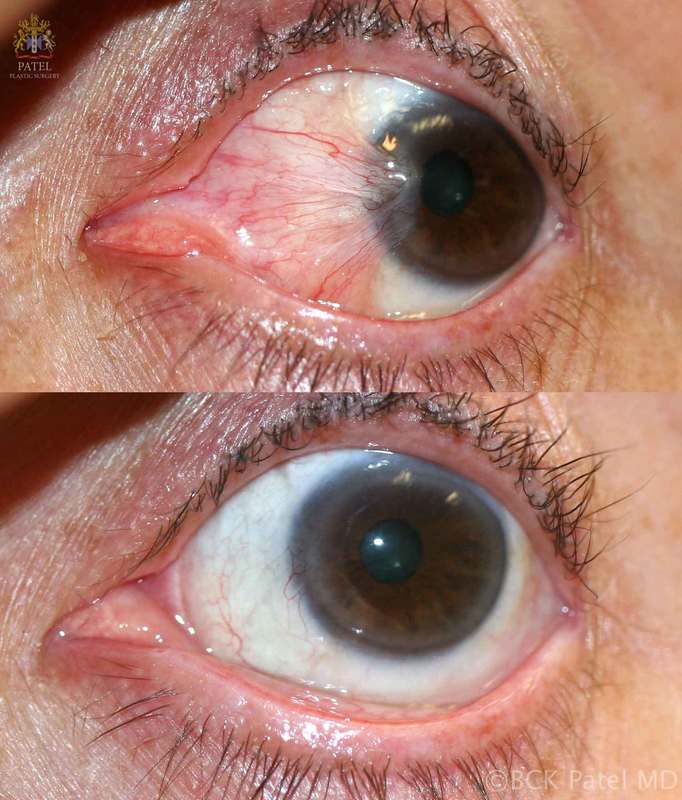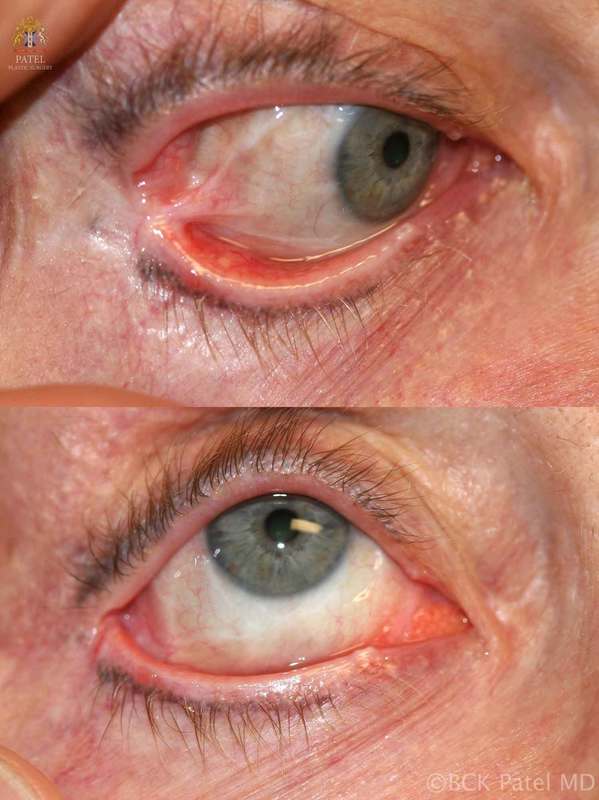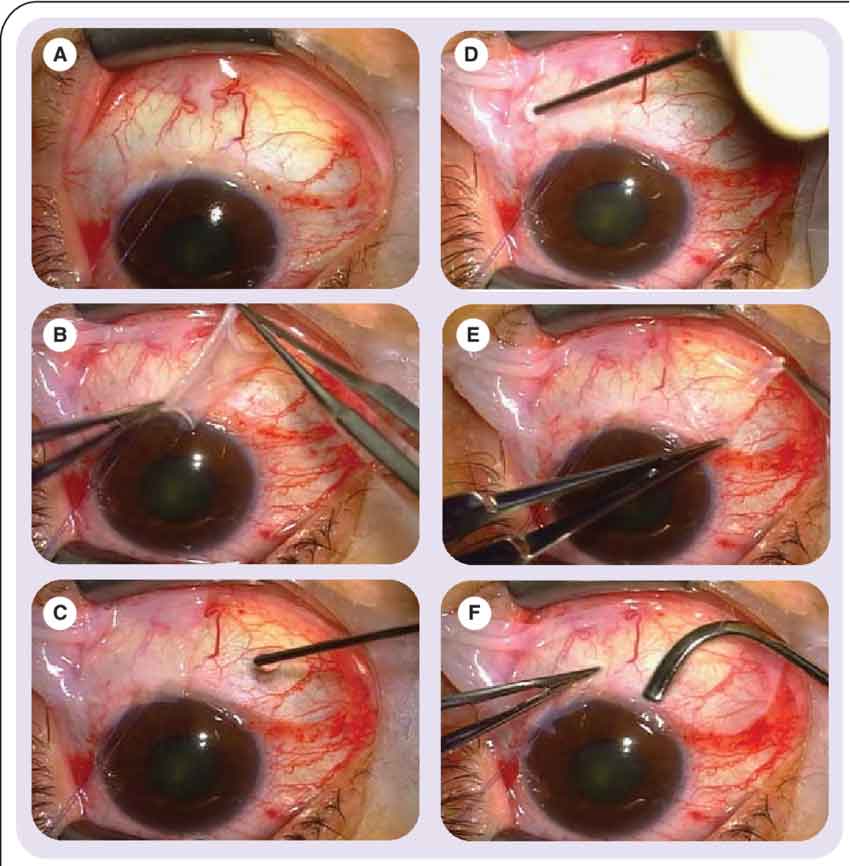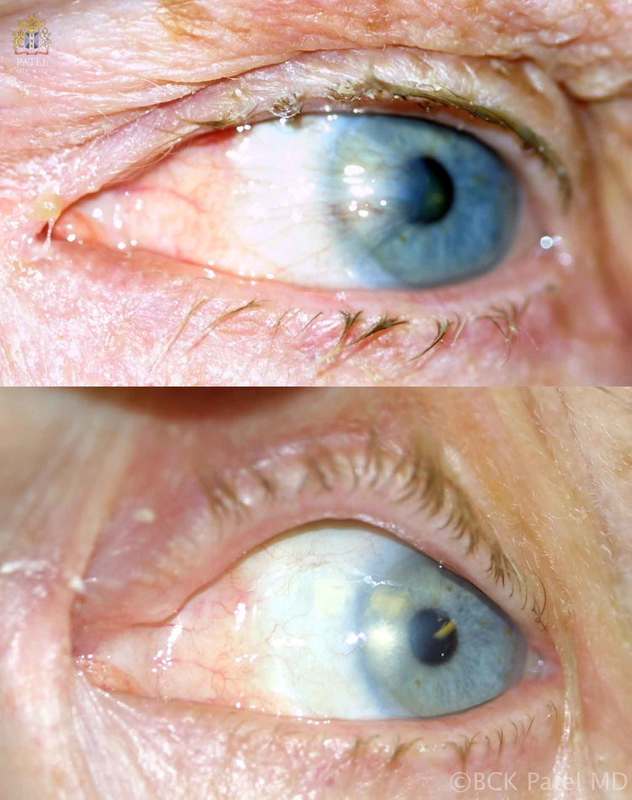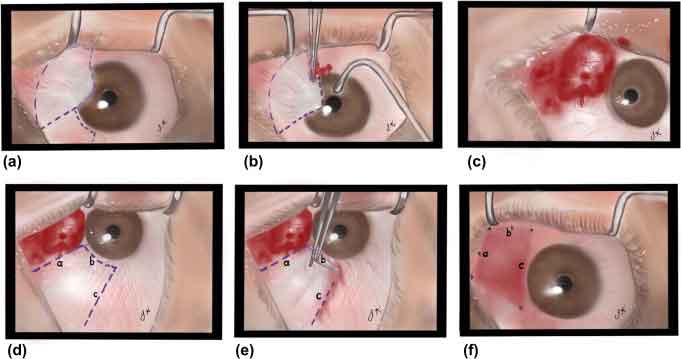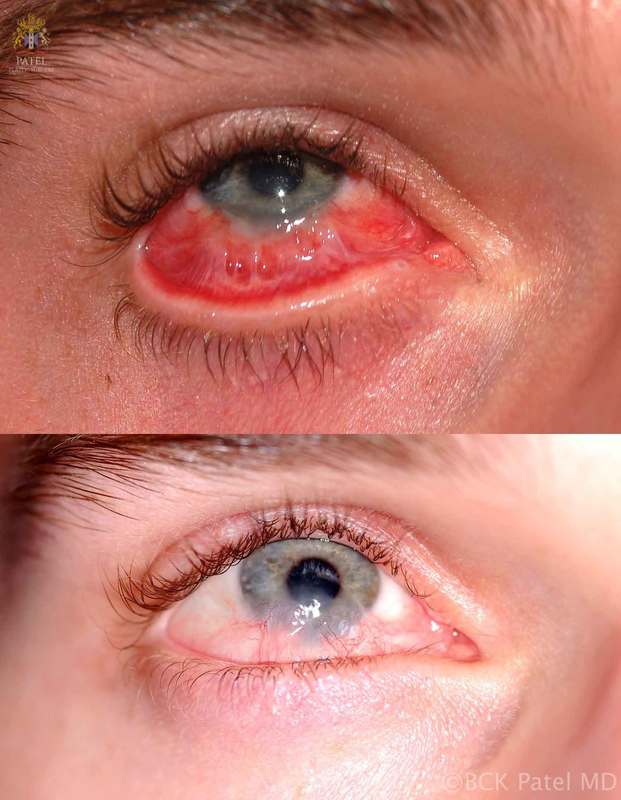What is a pterygium?
Pterygium refers to any wing-like triangular membrane occurring in the neck, eyes, knees, elbows, ankles or digits. The term comes from the Greek word pterygion meaning "little wing". From this was derived the Latin "pteryx" which means "winged one". First recorded use was 1562.
Pterygium (pronounced tur-IJ-ee-um) is a growth on the cornea (the clear front window of the eye) and the conjunctiva - the thin, filmy membrane that covers the white part of your eye (sclera). These growths are caused by dry eye, exposure to wind and dust, smoke, heat (industrial workers who work in furnaces, or welders) and UV (ultra-violet) exposure. For this reason, a pterygium is often called "a surfer's eye."
A pterigium usually grows on the nasal side of the eye, but can also grow on the lateral side and, in some patients, tends to be so extensive as to seem like it is growing from all directions! The reason why it is most often seen on the nasal aspect is thought to be because light reflects from the nose onto this surface and also because light from the lateral aspect passes through the cornea and is focused onto this area! In other words, this area gets more sun damage (and wind damage) than the lateral side.
A pingueculum is the early stage of damage to the conjunctiva when the growth is confined to the conjunctiva. Once it affects or crosses the limbus (the edge of the cornea), it is called a pterygium.
Pterygia are more common in men than ladies, and are seen more often the closer one is to the equator or to sunny and windy climates.
What symptoms does a pterygium cause?
In the early stages, pterygia may not cause any problems other than being visible as a red, elevated growth, oftenon the inner aspect of the white part of the eye. As they progress, patients may develop, increased redness, dryness, irritation and blurry or fluctuating vision. Patients who wear contact lenses may have difficulty comfortably wearing the lens.
|
|
(Advanced) information on pterygia for residents/fellows/surgeons/interested patients!
Pterygium in the conjunctiva is characterized by elastotic degeneration of collagen (actinic elastosis[12]) and fibrovascular proliferation. It has an advancing portion called the head of the pterygium, which is connected to the main body of the pterygium by the neck. Sometimes a line of iron deposition can be seen adjacent to the head of the pterygium called Stocker's line. The location of the line can give an indication of the pattern of growth.
The predominance of pterygia on the nasal side is possibly a result of the sun's rays passing laterally through the cornea, where it undergoes refraction and becomes focused on the limbic area. Sunlight passes unobstructed from the lateral side of the eye, focusing on the medial limbus after passing through the cornea. On the contralateral (medial) side, however, the shadow of the nose medially reduces the intensity of sunlight focused on the lateral/temporal limbus.[9]
Some research also suggests a genetic predisposition due to an expression of vimentin, which indicates cellular migration by the keratoblasts embryological development, which are the cells that give rise to the layers of the cornea. Supporting this fact is the congenital pterygium, in which pterygium is seen in infants.[13] These cells also exhibit an increased P53 expression likely due to a deficit in the tumor suppressor gene. These indications give the impression of a migrating limbus because the cellular origin of the pterygium is actually initiated by the limbal epithelium.[14]
The pterygium is composed of several segments:
- Fuchs' Patches (minute gray blemishes that disperse near the pterygium head)
- Stocker's Line (a brownish line composed of iron deposits)
- Hood (fibrous nonvascular portion of the pterygium)
- Head (apex of the pterygium, typically raised and highly vascular)
- Body (fleshy elevated portion congested with tortuous vessels)
- Superior Edge (upper edge of the triangular or wing-shaped portion of the pterygium)
- Inferior Edge (lower edge of the triangular or wing-shaped portion of the pterygium).
"Well, the last time I had a picture taken I could hardly see my eyes because of the weight of heavy eyelid. Then I paid attention to how I was actually using my eyes and I really noticed when I was looking at anything especially the computer I was straining my forehead to see better. Since I have had it done I no longer have to lift the forehead and tilt my head to see. It is amazing! I love..." D. Rock 63 Yrs Old with Fat Droopy Eyes - Salt Lake City, UT
What can I do to improve my symptoms?
|
|
what surgical approach is used to remove and repair a pterygium?
- A Cochrane review found conjunctival autograft surgery was less likely to have reoccurrence of the pterygium at 6 months compared to amniotic membrane transplant.(1) This is the technique we have perfected and we use this approach for primary and re-do procedures with excellent success. The additional use of mitomycin C is of unclear effect. Radiotherapy has also be used in an attempt to reduce the risk of recurrence.[4] However, it is very rarely used now. We haven't ever needed to use radiotherapy on our patients.
- Auto-grafting: conjunctival auto-grafting is a surgical technique that is an effective and safe procedure for pterygium removal. When the pterygium is removed, the tissue that covers the sclera known as the Tenons layer is also removed. Auto-grafting covers the bare sclera with conjunctival tissue that is surgically removed from an area of healthy conjunctiva. That “self-tissue” is then transplanted to the bare sclera and is fixated using tissue adhesive.
- Amniotic membrane transplantation: amniotic membrane transplantation is an effective and safe procedure for pterygium removal when used appropriately. Amniotic membrane transplantation offers practical alternative to conjunctival auto graft transplantation for extensive pterygium removal. Amniotic membrane transplantation is tissue that is acquired from the innermost layer of the human placenta and has been used to replace and heal damaged mucosal surfaces including successful reconstruction of the ocular surface. It has been used as a surgical material since the 1940s, and has been shown to have a strong anti-adhesive effect. Using an amniotic graft facilitates epithelialization, and has anti-inflammatory as well as surface rejuvenation properties.
- The postoperative care after a pterygium removal is just as important as the surgery. We will give detailed instructions to you after your surgery.
"How do you perform pterygium resection and repair?"
|
Use of amniotic membraneUnder certain circumstances, especially when we are referred patients with several prior surgeries, scarring, or lack of adequate availability of "clean" conjunctiva, we will use an amniotic membrane graft. The principles are similar to performing a primary pterygium resection but great care is needed to remove scar tissue, fibrous tissue and traction bands, together with fibrovascular connections to the caruncle or plica semilunaris which lead to recurrence.
The amniotic membrane is glued into position with care and protected with a contact lens. Postoperative care is similar to that after a primary pterygium but there may be other specific instructions we may give you. Some patients need eyelid or fornix surgery if there is double vision or traction on the eyelids which is sometimes seen in these more complicated cases. |
"I had to have pterygium surgery three times on my right eye and each time I had it grow back and left me with scarring and double vision. Dr. I am glad my doctor finally called Dr. Patel and discussed my case with him. Dr. Patel agreed to see me and he fixed me in one go! It was a long operation but worth every minute of it. I have no double vision and my eye actually looks white finally." T. Rodriguez. Highly recommended for pterygium surgery - Salt Lake City & Saint George, UT
|
|
Postoperative Care
|
Facts You should know
Blood ThinnersAspirin, aspirin-containing drugs, ibuprofen and other blood-thinners should be stopped 7 days before surgery. This includes herbs, all vitamins, & certain other drugs: we will give you a list which covers most such thinners. If you are on prescription blood-thinners like Coumadin or Plavix, we will advise you and your physician about possible changes in that medication prior to & after surgery.
|
VisionThere will be blurry vision during the healing phase: this may last from a few weeks to, sometimes, more than two months. Most patients can function
perfectly well but the refraction may change. Some patients need a refraction for new spectacles about two months(or more) after surgery as the corneal curvature will change (for the better) after surgery. |
conjunctival graftIt is normal for the conjunctival graft to look pink and sometimes swollen for the first few weeks. At times, blood can collect under the graft and the graft can look red: this is completely normal. To protect your conjunctival graft during sleep for the first week or two, we often ask patients to wear a shield on the operated eye at night.
|
SuturesWe almost never use sutures with pterygium surgery as we use medical tissue glue: this makes your healing more comfortable and faster. It also means you need steroid drops and ointment for a shorter period of time.
|
Dryness and Light-sensitivityThe reason why most people get pterygia is because of injury to the lining of the eye caused by ultraviolet light, heat, wind and dryness. When we remove the pterygium, the growth and irregularity are both handled, but the surrounding tissues will still have some degree of damage from prior injury. Therefore, some degree of dryness will still be there and you will need to use artificial tears as needed. There is a list of preservative-free drops and preserved drops and gels and ointments here.
|
Surgery Duration & Surgery TimesSurgery takes about 45 minutes, but we do not rush anything. When you come for surgery, please do not make any other appointments for the day as the duration of surgery is not always predictable. Also, by the nature of Medicine, emergencies are seen almost daily and may delay more routine cases. Furthermore, it is not uncommon
for the surgeon to take longer (or shorter) on some cases, depending upon findings: therefore, surgery times are ESTIMATES ONLY. |
AnesthesiaMost patients can have surgery with mild intravenous sedation. Although many people are squemish about things close to their eyes, almost everyone does very well with the appropriate level of sedation from my expert anesthesia team. Children will need a general anesthetic. Sometimes, when we are dealing with patients who are referred to us with complex recurrences of pterygia with extensive scarring, we will request a general anesthetic to be administered to make your surgery as comfortable as possible. My anesthesia team and I will discuss this with you and chose the best level of anesthesia for you so as to keep you comfortable.
|
Bruising & SwellingAlthough the graft and the conjunctiva are usually red for the first week, there will only be minimal bruising of the eyelids from the local anesthetic that is administered to you. You can use ice packs on the eye gently, although, with conjunctival grafts, we prefer you not to use ice as this can apply undue pressure on the conjunctival graft.
|
Additional Facts
recurrence of pterygiumAll operations have success and failure rates. Fortunately, with the modern techniques we use, recurrence of a pterygium is now rare. However, if one does not protect the eye from ultraviolet light, heat and dust and if artificial tears are not used as needed, there is a higher risk of recurrence of the pterygium. Some degree of redness of the graft and surrounding tissues will remain but this is not a recurrence.
|
What if i have had surgery somewhere else and i have a recurrencePlease bring photographs of your condition prior to surgery and your operation report when you come to see us. We will examine you and give you information on how matters can be improved.
|
Time off workIf your work involves heavy lifting or a lot of computer time, you would be wise to get a week off work.
Depending upon your specific requirements, we will be happy to give you a note for work. |
DiscomfortSurprisingly, most patients find they get very little discomfort after this surgery. You may need the prescription pain medication for one or two days; thereafter, simple over-the-counter pain medication like Tylenol suffices.
|
pingueculae
Often, patients will have a pterygium on one side which we will operate upon and either a small pterygium or a pingueculum on the other eye. All of these do not need surgery. If you begin to protect your eye from ultraviolet light and reduce dryness and direct heat injury to the eye (work, play, etc), you can slow down the growth of these pingueculae. If you do not have any symptoms and the growth is not distorting the cornea, there is no need to undergo surgery.
Do I Need This Surgery?Only if the pterygium causes irritation, dryness, or problems with vision
We will review your history and examine you: this will allow us to guide you as to whether the surgery may or may not be necessary. |
Persistent rednessThis is seen, as has been discussed above, with the chronic sun damage we often see in sunny climes: therefore, you should expect some degree of redness with dilated vessels which are the result of such chronic injury. Some redness of the graft is also to be expected. The chronic use of vasoconstrictor drops is NOT recommended.
|
Will my pterygium surgery be covered by Insurance?
Most insurances cover the surgical operation when it is performed for the appropriate reasons. If your insurance requires the submission of your history, findings and photographs to get pre-approval, we will ensure we do this.
How long does it take to get preauthorization from my insurance company?
Preauthorization may take four to six weeks from the time of submission of your information to the insurance company: we don’t have control over this, unfortunately.
use of flapsIn some cases, using our experience with reconstruction of the face with small and large flaps, we design the reconstruction after removal of the pterygium using similar flaps. These are accurately designed to cover the defect without tension and proper attention is paid to the conjunctiva, the Tenon's tissue and the corneal limbus.
|
How we used to remove and repair pterygia with sutures: of historical interest......
What kind of results can I expect?
|
|
|
Schedule Your Consult Today |
"Dr.Patel such a wonderful person...trust worthy, making u feel like family, included his staff members. Made my worries go away with there caring ways. God bless them. He truly make a wonderful job...it seem like a miracle. Dr. Patel makes magic happen." -Vitals.com Visitor Review
|
Visit Patel Plastic Surgery on YouTube for more free tips!
Stay Connected With Us On Social Media
|
Find UsDr. BCK Patel MD, FRCS
1025E 3300S Salt Lake City, Utah 84106, USA (801) 413-3599 (phone/text) E: [email protected] bckpatel.info Dr. BCK Patel MD, FRCS 585 E Riverside Dr Suite 201 Saint George, UT 84790 (435) 215-0014 E: [email protected] Quick-Link |
Let Us answer your questions |



